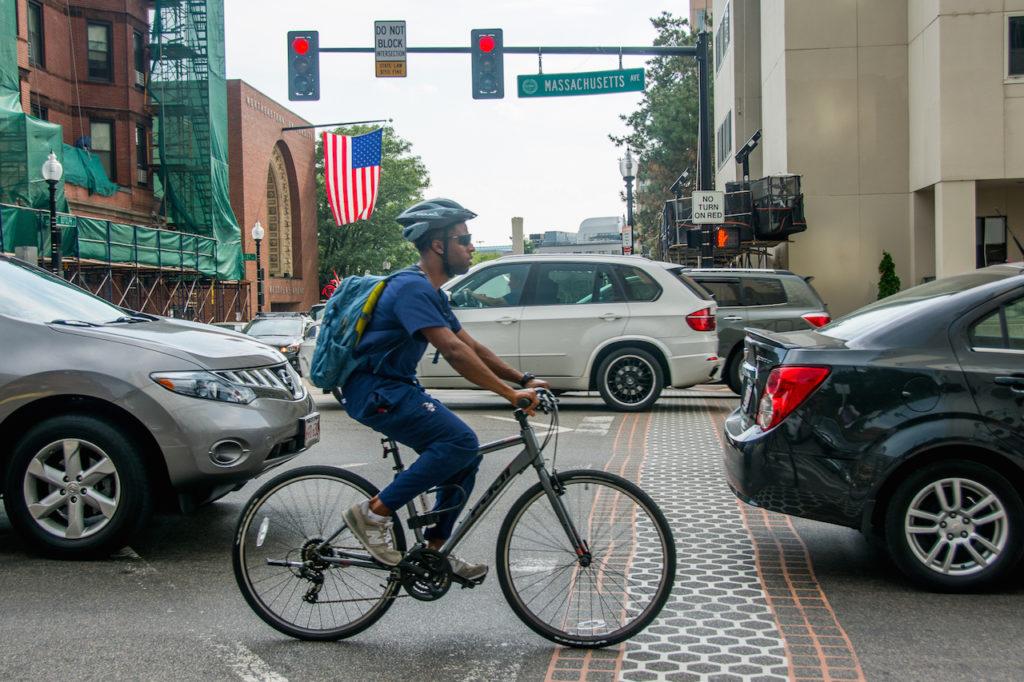By Audrey Cooney, news staff
The intersection of Massachusetts Avenue and Beacon Street is undergoing safety improvements in an effort to protect cyclists after Anita Kurmann, a 38-year-old surgeon, was struck and killed riding her bike there last month.
Bostonians will see modified signage, new bike boxes—designated areas for cyclists to stop between the crosswalk and the cars—and the creation of a bike lane at the intersection.
The intersection had been noted for the dangers posed to cyclists in the past, but the Aug. 7 death of Kurmann accelerated the city’s response to those problems, said Mayor Martin J. Walsh in a statement emailed to The News by spokeswoman Samantha Ormsby.
“The safety of all Boston’s residents and visitors is a top priority for the Walsh administration,” Walsh wrote. “We are fast-tracking a plan to upgrade the intersection at Massachusetts Avenue and Beacon Street to make our roads safer.”
Drivers heading southbound on Massachusetts Avenue will no longer be permitted to make right turns on red lights. Other signs reminding drivers to yield to cyclists and pedestrians are being installed.

Photo courtesy Samantha Ormsby
Flexible poles will create a physical barrier between the bike lane and vehicular traffic, something Cameron Parker, a sophomore civil engineering major and member of Northeastern University Huskies for Alternative Transportation, thinks will make the intersection much safer.
“There are certainly times where I’ve felt unsafe riding in Boston, having to be too close to cars going too fast,” Parker said. “Having something like a divider would absolutely help. I’ve had to be extra cautious at this particular intersection before, so these new additions make sense.”
The addition of bike boxes will alleviate some confusion regarding where bikers are meant to stop at traffic lights, according to J.T. Hinchen, a sophomore engineering major and regular cyclist.
“That’s a thing cyclists usually do anyway, but it’s nice to know it’s something that is actually being condoned by the city now,” Hinchen said.
However, he added, Boston has a long way to go to be considered a welcoming place for cyclists.
“Some of the outlying cities to Boston, like Cambridge and Brookline, are noticeably more bike-friendly,” Hinchen said. “There are more bike lanes and they’re much better maintained.”
The safety improvements at the intersection are part of a larger effort to make Boston’s streets safer and more inclusive, said Boston Transportation Department Commissioner Gina Fiandaca.
“Providing safe access on Boston’s local streets for all users is an ongoing effort that we are committed to striving for each day,” she said in an emailed statement to The News. “In keeping with this goal, in March of this year the City of Boston joined other major US cities in adopting Vision Zero, which is a policy based on the premise that traffic fatalities are not accidents, but rather crashes that can be prevented.”
The Vision Zero plan, which was developed in Sweden by the country’s National Road Administration in the 1990s, focuses on shifting the responsibility to keep roads safe away from road users and toward the design of the roads themselves. It has been adopted by several US cities including New York City, San Francisco and Chicago.
Boston launched its Vision Zero program alongside four other projects aimed at improving the safety of pedestrians, cyclists and drivers. The initiatives, announced in March of this year, fall under the umbrella of Go Boston 2030, the city’s plan to modernize Boston’s roadways over the next 15 years.
While the programs may bring a decline in cycling accidents, city bikers aren’t convinced that their problems will disappear.
The safest solution for cyclists—a physical separation between themselves and drivers—isn’t always possible, Hinchen said. Often, a cyclist’s next best approach is remembering that the roads were built for them as well as for vehicles.
“You need to behave like a car,” Hinchen said. “You can’t be afraid to take up space.”
Ultimately, cyclists say, it may not be possible to ever make it fully comfortable to ride in the city.
“I definitely feel like a lot of drivers seem very reluctant to have cyclists on the roads,” Parker said. “It’s not too uncommon to be yelled at for actually following the laws.”
That tension between drivers and bikers may be inescapable no matter what changes are made, Hinchen said.
“I just don’t think cyclists feel welcome on any urban road,” he said.
Photo by Brian Bae









